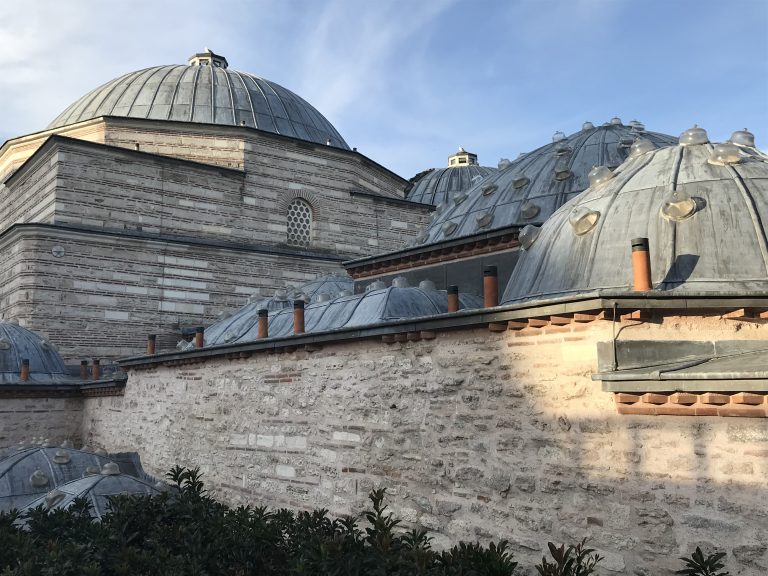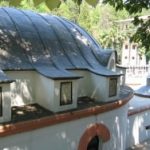Turkey has a long history of public bathing stretching right back to Roman times. The modern hamam or Turkish bath is merely an updated version of the old Roman bathhouse and played an essential part in household life right into the 20th century when the gradual arrival of home bathing facilities starting to wipe them out, especially for women. In the 21st century hamams have found new life as tourist attractions even as they are abandoned by their original clientele. This is especially true in İstanbul where several historic hamams have been brought back to life or have been upgraded to offer a less rough and ready service than used to be the case. At the same time many upmarket hotels have installed their own private hamams where their customers can experience the general idea of a Turkish bath without having to brave the unknown of a public bathhouse.
First-time visitors to a hamam are often unsure what to expect but there is nothing to worry about if you stick with one of the most popular İstanbul baths such as Ayasofya Hürrem Sultan Hamamı, Cağaloğlu, Çemberlitaş, Kılıç Ali Paşa or Galatasaray that is used to dealing with foreigners.
The protocol is fairly standard. Most hamams have a large camekan (lobby) where bathers undress and leave their clothes and valuables in lockers or cubicles. Here, too, they will pick up a peştemal, a giant tea-towel-like garment that is used for modesty, as well as terlik (slippers) to walk on the soapy floor and a tas (bowl) that is used to pour water over the body. Hamams usually supply basic soap and shampoo although you may prefer to bring your own to be sure of the quality.
The camekan usually opens into a soğukluk, or cold room, where the showers and toilets are located. Some hamams have a small plunge pool here; many also have an area set aside for shaving body hair.
From the soğukluk you move into the hararet, or hot room, which normally centres on a göbektaşı, or marble slab, where bathers can stretch out and relax, and then have a massage.
The room will be ringed with kurnas (basins), with taps that enable individuals to adjust the temperature of the water to their liking. You scoop water over yourself using the tas, trying not to let any soap drip into the kurna.
When your turn comes, the masseur/masseuse will scrub you down with a kese, a rough mitten with the texture of a cat’s tongue, removing layers of dirt you wouldn’t have believed existed. Afterwards they sometimes buffet you with a pillowcase filled with soap or massage you with soap.
Finally you will be rinsed off, wrapped in thick white towels and sent back to the camekan to relax with a glass of çay.
Hamams can be found all over Turkey with the experience of using them getting steadily rougher (and cheaper) the further east you travel. Fewer baths still open for women than for men although in tourist resorts some baths offer mixed bathing, a big no-no in traditional Turkish society. Away from İstanbul prices will be lower although they’re hardly dirt-cheap in big cities such as Bursa which is well-known for its thermal waters. In the resorts purpose-built modern hamams usually decide their prices with the tourist euro in mind.
Outside İstanbul there are historic hamams worth visiting in Safranbolu, Selçuk and Trabzon. The baths in Tokat are especially worth visiting because many of the masseurs in the west of the country either learned their craft there or are descended from masseurs who did.
Some hamams used to have a reputation as unofficial meeting places for gay men although this is less often the case as they are taken upmarket.
İstanbul’s finest historic hamams
Ağa Hamam, Ağa Hamamı Sokak No. 60, Çukurcuma, Beyoğlu, Tel: 0212-249 5027
Ayasofya Hürrem Sultan Hamam Ayasofya Meydanı, Sultanahmet, Tel: 0212-517 3535
Büyük Hamam Bülent Demir Caddesi No. 14/A, Kasımpaşa, Tel: 0212-253 4229
Cağaloğlu Hamam Prof. Kasım İsmail Gürkan Caddesi No. 24, Tel: 0212-522 2424
Çemberlitaş Hamam Vezirhan Caddesi No. 8, Tel: 0212-522 7974
Çinili Hamam, Üsküdar Çavuşdere Caddesi, Çinili Hamam Sokak No. 6, Üsküdar, Tel: 0216-334 9710
Çinili Hamam, Zeyrek İtfaiye Caddesi No 44, Zeyrek, Fatih, Tel: 0212-521 2161
Çukurcuma Süreyya Hamam Hamamhane Hotel, Çukurcuma Caddesi No. 57, Çukurcuma Tel: 0212-243 6480
Galatasaray Hamam İstiklal Caddesi, Turnacıbaşı Sokak No. 24, Beyoğlu, Tel: 0212-252 4242
Gedikpaşa Hamam Emin Sinan Caddesi No. 61, Gedikpaşa, Tel: 0212-517 8956
Kadırga Hamam Kadırga Liman Caddesi No. 69, Kadırga, Tel: 0212-518 9148
Kılıç Ali Paşa Hamam Hamam Sokak No 1, Kılıç Ali Paşa Cami yanı, Tophane, Tel: 0212-393 8010
Mihrişah Sultan Hamam Fevzi Paşa Caddesi No. 333, Fatih, Tel: 0212-523 0487
Süleymaniye Hamam Mimar Sinan Caddesi No. 20, Beyazıt, Tel: 0212-519 5569
If you can find a copy, Orhan Yılmazkaya’s Turkish Baths: A Guide to the Historic Turkish Baths of Istanbul has details of most bathhouses in the city.
Read a personal account of visiting a hamam: The Hamam Experience


